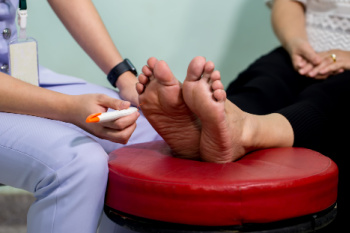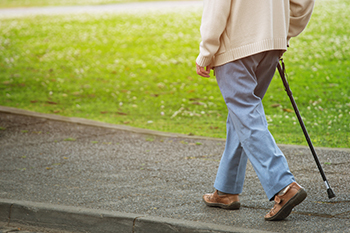
Comfort and physical well-being play a critical role in workplace performance, especially for employees who spend long hours on their feet or experience discomfort from poor foot mechanics. Custom orthotics provide tailored support that aligns the feet, improves posture, and reduces fatigue. When foot pain or discomfort is minimized, employees are more focused, energized, and less likely to take breaks or miss work due to physical strain. These devices also help prevent common issues, such as plantar fasciitis and lower back pain, leading to improved overall health and job satisfaction. If you have foot discomfort from your job, it is suggested that you speak with a podiatrist about how custom-made orthotics can help you.
Discover relief from persistent foot pain with custom orthotics and shoe inserts. If you’re battling heel pain, these personalized solutions offer targeted support, addressing the root causes of discomfort. Customized to your unique biomechanics, these inserts provide stability, alleviating both heel and foot pain. Say goodbye to the agony of every step and hello to a life free from constant foot pain. Invest in your well-being with custom orthotics or shoe inserts ensuring your feet receive the care they deserve. Step confidently, step comfortably – because a pain-free journey begins with the right support.
If you have any questions please contact our offices located in Covina and Alta Loma, CA . We offer the newest diagnostic and treatment technologies for all your foot and ankle needs.

Neuropathy is a condition that affects the nerves, often causing pain, tingling, numbness, or weakness in the feet. It is commonly linked to diabetes, but can also result from injuries, infections, vitamin deficiencies, or exposure to certain toxins. Over time, damaged nerves can make it difficult to feel sensations or control muscle movement in the feet. Symptoms may begin subtly with a tingling or burning feeling, then progress to sharp pain, numbness, or a pins and needles sensation. Some people may also notice muscle weakness or a loss of balance. These symptoms can interfere with daily activities and increase the risk of foot injuries. A podiatrist can diagnose neuropathy through a physical exam and tests to assess nerve function. Treatment options include medication to manage pain, lifestyle recommendations, targeted exercises, and custom orthotics to support foot health and reduce pressure. Preventing further nerve damage is a key focus. If you have symptoms of this condition, it is suggested that you schedule an appointment to see a podiatrist for a diagnosis and appropriate treatment.
Neuropathy
Neuropathy can be a potentially serious condition, especially if it is left undiagnosed. If you have any concerns that you may be experiencing nerve loss in your feet, consult with one of our podiatrists from Bruening Foot & Ankle. Our doctors will assess your condition and provide you with quality foot and ankle treatment for neuropathy.
What Is Neuropathy?
Neuropathy is a condition that leads to damage to the nerves in the body. Peripheral neuropathy, or neuropathy that affects your peripheral nervous system, usually occurs in the feet. Neuropathy can be triggered by a number of different causes. Such causes include diabetes, infections, cancers, disorders, and toxic substances.
Symptoms of Neuropathy Include:
- Numbness
- Sensation loss
- Prickling and tingling sensations
- Throbbing, freezing, burning pains
- Muscle weakness
Those with diabetes are at serious risk due to being unable to feel an ulcer on their feet. Diabetics usually also suffer from poor blood circulation. This can lead to the wound not healing, infections occurring, and the limb may have to be amputated.
Treatment
To treat neuropathy in the foot, podiatrists will first diagnose the cause of the neuropathy. Figuring out the underlying cause of the neuropathy will allow the podiatrist to prescribe the best treatment, whether it be caused by diabetes, toxic substance exposure, infection, etc. If the nerve has not died, then it’s possible that sensation may be able to return to the foot.
Pain medication may be issued for pain. Electrical nerve stimulation can be used to stimulate nerves. If the neuropathy is caused from pressure on the nerves, then surgery may be necessary.
If you have any questions, please feel free to contact our offices located in Covina and Alta Loma, CA . We offer the newest diagnostic and treatment technologies for all your foot care needs.

As people become frail with age, their feet often reflect this decline. Weakness, thinner skin, and poor circulation can make the feet more vulnerable to injury and infection. Balance issues and reduced mobility may lead to falls or pressure points, which can cause sores or joint problems. Even minor foot concerns, like a callus or toenail issue, can become serious in someone who is frail. In many cases, these individuals may not feel pain clearly or may not notice early signs of trouble. Regular foot checks and gentle care are essential to protect skin integrity and maintain mobility. Addressing concerns early helps avoid complications that could reduce independence or lead to hospitalization. If you or someone you care for is experiencing foot problems along with increased frailty, it is suggested you see a podiatrist for a diagnosis and appropriate treatment.
If you need your feet checked, contact one of our podiatrists of Bruening Foot & Ankle. Our doctors will attend to all of your foot and ankle needs and provide you with quality treatment.
Geriatrics and Podiatry
When people age, some common issues that may occur are bone density loss, dry skin, poor circulation, and rough brittle nails. These issues may also affect your foot health if the necessary steps are not taken to alleviate the problems.
It is important to take care of your feet because feet that are injured or diseased can affect your overall health. Having painful feet hinders your ability to do daily activities or may decrease your willingness to do the things that you need to do.
Visiting Your Geriatrician
As we age, health problems become more likely, so it is essential to visit your doctor for check-ups to ensure that you are doing the best you can to take care of your health. It is recommended to check your feet frequently for any possible cuts, bruises, swelling, corns or any other irregularities.
Taking Care of Elderly Feet
Cracked or dry feet can be treated by applying moisturizer often. It is also important not to wear old socks because the older the sock is, the higher the possibility there will be that there is bacteria there. Wear fresh socks and make sure they fit properly.
Proper foot health means that you can have a more active lifestyle and you will not be bogged down by pain. Foot health also leads to good circulation, which is paramount for overall health.
If you have any questions, please feel free to contact our offices located in Covina and Alta Loma, CA . We offer the newest diagnostic tools and technology to treat your foot and ankle needs.

